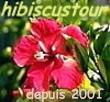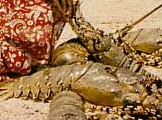-

"hibiscustour", three separate sites -
Islands and lagoons New Caledonia, Polynesia (part). -

Curiosity. Things, amazing, science, society.. -

Ideas perso. Household, Practical life, D.I.Y, Computering..
 
but reality |
  |
|
|
 Beautiful lobsters "porcelain" ; along with their antennae, they are nearly as large as the little boy.
Beautiful lobsters "porcelain" ; along with their antennae, they are nearly as large as the little boy.
|
| If Nouméa has changed a lot, the bush did not change in the same way. What's more, it is not América here, but the opposite : kanak people have only accepted hotels in their territory and put in fire to some houses in small villages ; bridges have been dded since and most of roads are now sealed and in good repair. However, it's also a travel in the time going both in the bush and islands. |
For my pleasure, that I wish also yours, there was this young coconut, a little on the left of the rock, which will undoubtedly never have had time to grow. On the right, one distinguishes the reef at low tide, which line the rock.. |
|
|
|
the niaoulis tree has invaded the whole west coast. |
f small village |
The stockmen, gauchos of New Caledonia. |
The niaouli tree is a big problem due to its fast growing and vast spreading. Eradication is difficult and farmers keep fighting against it with all means they can afford, like machines or simple pealing.
|
|
Bourail : the man> |
|
|
|
|
|
|
|
|
|
Low vegetation on a small island ; here, not any coconut tree to make some shade. |
|
Low tide: coral outcrop. |
|
|
|
|
|
|
The season of cyclones goes from late December to March ; this above pictures are those of the very strong cyclone " "Colleen", in 1969, which had struck Nouméa in the middle of the
night, with one moment of lull when passing the eye of the cyclone, followed by a violent resumption of the winds in reverse direction afterwards. At this time, one had the
impression that what had held until there, was going to blow up under the effect of the changing direction.
There were kinds of powerful vibrations, of true blow of ridge-plough in fact, in gust, "boom boom boom!!", who were violent waves of successive compressions adding again themselves to the elements in fury.
It was enough terrifying. We had put the cupboard behind the wide picture window and we were right because that of the side apartment, fortunately vacant, was
half tilted, the casing being badly bond with only a few nails in masonry; its walls were fired with salt.
The following day, the sea level, pushed by an exceptional tide and waves, was above the quays and I drowned a car while trying to pass, water was at my size after having opened the door. One 4-4 fortunately towed me. There were iron sheets everywhere and they are truly very dangerous because they plane with force; falls of branches and trees too of course, and that was much more terrible for those which could not shelter any more. |
The TV braodcast aerial had been carried out. Generally, the permanent structures resist well and only the roofs can be damaged. They are always the evil placed which suffers from it more, the precarious dwellings being demolished. The trees did not have any more leaves or they were all black, just as the whole vegetation, burned by the salt and the projection of particles (sand, fine gravels..). A friend of mine had stones on his terrace however located at several meters in height. The famous royal palm trees of the coconuts square did not have any more palms, nor the coconuts trees or they were burned ; it was thought that it was rotten for a long time, but actually, the vegetation regain rather quickly. The most spectacular damage is always at the seaside with boats tangled up or projected on the bank or even the road; photographers give there the greatest attention. Since Colleen (1969), Alison, struck Touho in 1975, Anne deprived Nouméa of water (1988) and Béti, 1996, was the less violent. Erika on 14 March 2003 was a very violent àne(more than 200 km/h) although it was perhaps the shorter. Considerable damage every time. fortunately, it circulated very quickly, especially after having approached the surroundings of the Great land between Koumac and Koné towards 6h of the morning, 40 with 50kmh of displacement, the eye passed on Noumea at midday; the "blow of west" started with 1h, very violent but very short. Calms had returned to 6h. We had few serious dégats. Some broken branches of our lemon tree, the garden well ransacked but in the final analysis more fear that harm for us. At the Anse-Vata and the Orphelinat bays, old trees were uprooted and on the place (square) des Cocotiers let us not speak about it. But the worst it is in the bush, Bourail suffered much like Poya and Koné. Hundreds electric posts down to ground, torn off roofs, telephone cut |

|